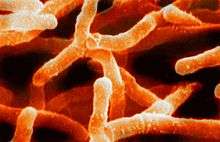Actinomycetales
The Actinomycetales are an order of Actinobacteria. A member of the order is often called an actinomycete.
| Actinomycetales | |
|---|---|
 | |
| Scanning electron micrograph of Actinomyces israelii. | |
| Scientific classification | |
| Domain: | Bacteria |
| Phylum: | Actinobacteria |
| Class: | Actinobacteria |
| Subclass: | Actinobacteridae |
| Order: | Actinomycetales Buchanan, 1917 |
| Suborders/Families | |
| |
The actinomycetes are diverse and contain a variety of subdivisions, as well as yet-unclassified isolates, mainly because some genera are difficult to classify because of a highly niche-dependent phenotype. For example, Nocardia contains several phenotypes first believed to be distinct species before their differences were shown to be entirely dependent on their growth conditions.
Actinomycetales are generally gram-positive and anaerobic and have mycelium in a filamentous and branching growth pattern. Some actinobacteria can form rod- or coccoid-shaped forms, while others can form spores on aerial hyphae.
Actinomycetales bacteria can be infected by bacteriophages, which are called actinophages.
Actinomycetales can range from harmless bacteria to pathogens with resistance to antibiotics.
Difficulty of classification
Actinomycetales are Gram-positive, but several species have complex cell wall structures that make the Gram staining unsuitable (e.g. Mycobacteriaceae). Actinomycetales have prokaryotic nuclei, are susceptible to antibiotics, and have cell walls that contain muramic acid much like bacteria. Actinomycetales have the appearance of filaments or hyphae, superficially resembling many forms of hyphal fungi.
Reproduction
Actinomycetales have 2 main forms of reproduction; spore formation and hyphae fragmentation. During reproduction, Actinomycetales can form conidiophores, sporangiospores, and oidiospores. In reproducing through hyphae fragmentation, the hyphae formed by Actinomycetales can be a fifth to half the size of fungal hyphae, and bear long spore chains.
Presence and Associations
Actinomycetales can be found mostly in soil and decaying organic matter, as well as in living organisms such as humans and animals. They form symbiotic nitrogen fixing associations with over 200 species of plants, and can also serve as growth promoting or biocontrol agents, or cause disease in some species of plants. Actinomycetales can be found in the human urogenital tract as well as in the digestive system including the mouth, throat, and gastrointestinal tract in the form of Helicobacter without causing disease in the host. They also have wide medicinal and botanical applications, and are used as a source of many antibiotics and pesticides.
Antimicrobial properties
Many species of Actinomycetes produce antimicrobial compounds under certain conditions and growth media. Streptomycin, actinomycin, and streptothricin are all medically important antibiotics isolated from Actinomycetes bacteria.[1] Almost two-thirds of the natural antimicrobial drug compounds used currently are produced by different species of Actinomycetes.[2]
See also
- Actinobacteria#Phylogeny, shows about 20 species
References
- See the NCBI webpage on Actinomycetales Data extracted from the "NCBI Taxonomy Browser". National Center for Biotechnology Information. Retrieved 2011-06-05.
- "Actinomycetales - List of Prokaryotic names with Standing in Nomenclature". Retrieved 2016-10-04.
- Labeda; et al. (2011). "Abstract of Reassessment of the systematics of the suborder Pseudonocardineae: transfer of the genera within the family Actinosynnemataceae Labeda and Kroppenstedt 2000 emend. Zhi et al. 2009 into an emended family Pseudonocardiaceae Embley et al. 1989 emend. Zhi et al. 2009". International Journal of Systematic Evolutionary Microbiology vol. 61. pp. 1259–1264. Archived from the original on 2015-02-10. Retrieved 2011-06-11.
- Waksman, Selman A.; Schatz, Albert; Reynolds, Donald M. (December 2010). "Production of antibiotic substances by Actinomycetes". Annals of the New York Academy of Sciences. 1213 (1): 112–124. doi:10.1111/j.1749-6632.2010.05861.x. PMID 21175680.
- Bentley, S. D.; Chater, K. F.; Cerdeño-Tárraga, A.-M.; Challis, G. L.; Thomson, N. R.; James, K. D.; Harris, D. E.; Quail, M. A.; Kieser, H.; Harper, D.; Bateman, A.; Brown, S.; Chandra, G.; Chen, C. W.; Collins, M.; Cronin, A.; Fraser, A.; Goble, A.; Hidalgo, J.; Hornsby, T.; Howarth, S.; Huang, C.-H.; Kieser, T.; Larke, L.; Murphy, L.; Oliver, K.; O'Neil, S.; Rabbinowitsch, E.; Rajandream, M.-A.; Rutherford, K.; Rutter, S.; Seeger, K.; Saunders, D.; Sharp, S.; Squares, R.; Squares, S.; Taylor, K.; Warren, T.; Wietzorrek, A.; Woodward, J.; Barrell, B. G.; Parkhill, J.; Hopwood, D. A. (9 May 2002). "Complete genome sequence of the model actinomycete Streptomyces coelicolor A3(2)". Nature. 417 (6885): 141–147. doi:10.1038/417141a. PMID 12000953.